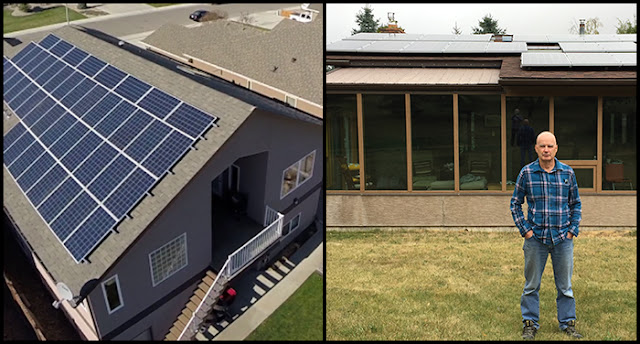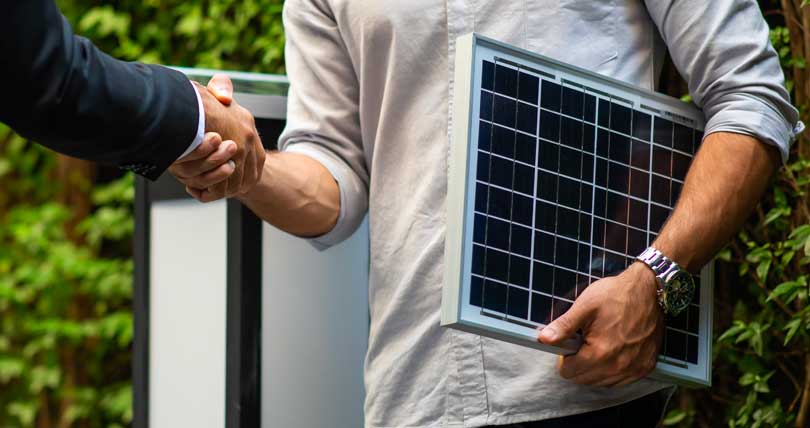By: Deanna McArthur
Renewable Energy, specifically solar power, has been a popular topic of discussion in Alberta recently.
On the first day of summer, the government announced the official launch of Energy Efficiency Alberta’s $36 million Residential and Commercial Solar Program. Under the program, homeowners can receive up to 30% off solar panel installation costs, to a maximum rebate of 10,000. Businesses and non-profit organizations are eligible for up to 25% of system costs, to a maximum rebate of $500,000.
In addition to this announcement, in December of last year the government announced a change to Alberta’s Micro-Generation regulation. The changes included increasing the size limit from one megawatt to five megawatts and allowing a micro-generating system to serve adjacent sites.
With items like this, it is no wonder solar has been top of mind for many in Alberta, including us here at Spot Power.
One of the core beliefs of our business is in addressing climate change, and encouraging energy efficiency initiatives. Over the last decade we have supported a number of green energy initiatives such as providing the opportunity for our customers to green a percentage of their energy usage through the purchase of Renewable Energy Certificates (RECs) and our Light Up Alberta program for solar PV micro-generators in partnership with Green Alberta Energy. These programs are not subsidized by the government but rather financed and promoted by ourselves as we believe in the importance of the environmental benefits.
Special Rate Created for Large Solar PV Micro-generators
In June, we decided to begin offering a special electricity rate of 12.5 ₵/kWh for large PV micro-generators who were generating more electricity than they were using. We did this in hopes it would aid in maximizing their return on investment for their solar systems.
We spoke to two of our micro-generation customers about how they have incorporated solar into their homes, the benefits they have seen, and the value our special rate has brought them.

Spot Power (SP): please tell us about your solar system
David Takeda (DT): Our solar panels were installed in 2014. We have 48 solar panels at 260 watts each that were installed on the south slope of our house. The annual solar production target of our system is 18,978 kWh. The max single day solar electricity produced since installation was on June 5, 2016 at 95.3 kWh. As of today, we have recorded 57.1 megawatt-hours of solar electricity production.

SP: what was the reason you originally decided to invest in a solar system?
DT: I believe I need to do my part in reducing the environmental impact of living and enjoying life. I have no intention of moving to “off the grid”, or going to extremes to reduce energy dependence, but I will do as much as I can.
In fact, the solar panels are one part of the whole program. When we built our home, we did a lot of research on what to include in our energy efficient home, at the time we decided a solar system was too expensive, but we purposely bought a lot with the long side facing south and built a roof that would allow for maximum solar efficiency. Initially we installed geothermal heating/cooling, a Stiebel Eltron Accelera heat pump hot water tank and a TED system to monitor our homes energy use.
We built our home as a long-term investment and intend to retire here. So, everything we chose to include in the home was taking that into consideration (think 30 years).
The solar panels were installed in 2014. Since we are able to meet our calculated whole house annual energy use, that moved us from an initial EnerGuide Rating of 88 to our current rating of 100. I was happy to achieve this rating!
SP: How much did you originally invest in your solar system?
DT: The total installed cost in June 2014 was $36,500. We did not have any hope of grant money to help pay for the system like you are seeing with the implementation of the new government programs.
I expect it will take up to 15 years to get our investment back, but now with Spot Power’s 12.5 cent/kWh PV solar rate, that time frame will be reduced.
15 years sounds like a long time, and it is, but we have lived in our home for seven years now (three of those with solar) so time does go by quickly. When the 15 years are up, our energy cost will be limited, regardless what energy prices do. That seems like a pretty good investment to me.
SP: Are there any drawbacks of having a solar system?
DT: Cost is a deterrent for many people, and I would not invest money into these options for a short-term home. Cash is needed up-front, but I fully expect each item we installed to pay itself back… eventually.
I could have spent the money on an expensive vehicle that would not pay me back. I instead chose to invest money into something that has a payback advantage, and when we do sell our home, I also expect to capture a premium compared to a similar home without the energy and environmental considerations.
Costs are coming down and technology is improving, so solar PV systems will become more and more affordable. I think the current government is doing a great job of accelerating renewable energy acceptance.
SP: Would you recommend installing solar to others in Alberta?
DT: I would definitely encourage others to invest in a PV solar system, especially with the grant money now available to help offset a good portion of the investment cost. For me, it is about doing my part to maximize renewable resources and thus reduce our environmental impact.
SP: What do you think of Spot Power’s 12.5 cent rate for large solar micro-gen customers?
DT: Nick Clark, co-owner of Spot Power, has always been on the forefront of offering electricity retail alternatives. We signed up with Spot Power in September of 2010 and Nick has always been available to answer questions, even late at night or when he is on holidays.
Now, with the 12.5 cent solar option, I have been able to gain a significant credit on my solar bill for the month of July. One advantage that Spot Power offers, is that I am not locked into the contract price, I can switch off of this rate with just 10 day’s notice and no penalty whatsoever. Today, I am buying what I need from the grid at 12.5 cents per kWh and export at the same rate. I can switch over to their low floating rate, which is currently 3.4 cents at any time in the future. I will want to do this for the six months of October to March as my solar system will swing to importing more electricity than I am exporting and I would not want to get caught paying 12.5 cents/kWh for those six months of the year! This plan puts me in control over my cost of energy.
Take a look at David’s Spot Power invoice for July, 2017 and see how much he was able to save on the special PV solar micro-gen rate. Click here.

Spot Power (SP): please tell us about your solar system.
Brian Hunter (BH): Our MD Foothills solar system is comprised of 32 panels, 315 watts each. We have two 600-volt charge controllers, a 6,800-watt inverter, 24 6-volt lead acid storage batteries and a 5,000-watt backup generator.

SP: what was the reason you originally decided to invest in a solar system?
BH: I obtained my first solar system in the late 1990’s, a 12-volt system for an off-grid cabin in Cardston County. This was a practical way to power lights in a small seasonal cabin with no grid connection. We moved from Calgary to MD Foothills in 2015, and with an abundance of south facing roof space, it seemed not unreasonable to put a solar system there.
The installation was more of a science experiment or lifestyle choice rather than a business decision to reduce costs. This may change over time, but not something I would count on.
The system provides self-sufficiency and is a standalone power source with the grid as a backup. We experienced numerous short term outages prior to the installation of our system and our neighbours had told us stories of a three-day outage in 2010. Now, we are unaffected by grid outages and can be reasonably certain that future electricity costs will be minimal. Self production and the sale of excess electricity to the grid in summer months should be sufficient to offset any imports from the grid in the winter months.
SP: How much did you originally invest in your solar system?
BH: The total cost of our system was about $45,000, it is possible that I will get some of that returned as a grant from the Alberta Government, however that discussion is ongoing due to an inverter manufacturer warranty issue.
At existing energy prices, we expect to save about $200 on energy this year and $1,000 on transmission/distribution charges. With changes expected in Alberta’s electricity market, I expect prices will at least triple, so the potential for greater savings moving forward is possible. Additionally, as the goal for 30% of energy to be provided by renewables by 2030 approaches, there will no doubt be new infrastructure required, which will mean an increase in transmission and distribution charges and another potential for me to increase my savings.

SP: Are there any drawbacks of having a solar system?
BH: My firmware does not function as promised with regard to using battery storage vs purchasing power from the grid. I am working through these issues with my manufacturer and installer and expect these start-up issues to be sorted out soon. The inverter does make some noise (hum) when operating, which some might find troublesome and the system takes up floor space (batteries in particular) so you need a suitable area in which to install it.
SP: Would you recommend installing solar to others in Alberta?
BH: Yes, I can recommend others to do similar, depending on their situation. This is a long-term capital investment, which will hopefully provide many years of service. It will add value to my home similar to how other renovations might, but this wouldn’t be something to undertake if a move is planned anytime soon. I would not expect the value of the solar system to add anywhere near a 1:1 on dollar basis to resale value, but it does add some value. With the current Alberta subsidy program and the relentless drop in the cost of solar equipment, it is as good a time as any for those that are included to be electricity self-sufficient.
SP: What do you think of Spot Power’s 12.5 cent rate for large solar micro-gen customers?
BH: I was delighted to find out Spot Power was offering a 12.5 cent rate. I believe it allows for a reasonable return from power sold to the grid that recognizes the actual cost of generating the power from solar. We will see how it works out over a 12-month period!
Take a look at Brian’s Spot Power invoice for July, 2017 and see how much he was able to save on the special PV solar micro-gen rate. Click here.
If you are a large a PV Micro Generator that exports electricity to the grid more than you are importing, you may find Spot Power’s 12.5 cent/kWh rate of interest. Additionally, all micro-gen customers are given a subsidy of an additional 1 cent per kWh for what they export to the grid, financed through a private trust fund set up by Nick Clark and his business partner Madeline Low.
Contact us for more information on this special rate.




